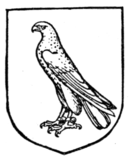representation always shows it as a white eagle. It is however seldom met with, though it figures in the crests of Roche (Lord Fermoy) and Trist. The osprey is sometimes known as the sea-eagle, and heraldically so termed.
The Vulture (probably from its repulsive appearance in nature and its equally repulsive habits) is not a heraldic favourite. Two of these birds occur, however, as the supporters of Lord Graves.
The Falcon (Fig. 461) naturally falls next to the eagle for consideration. Considering the very important part this bird played in the social life of earlier centuries, this cannot be a matter of any surprise. Heraldry, in its emblazonment, makes no distinction between the appearance of the hawk and the falcon, but for canting and other reasons the bird will be found described by all its different names, e.g. in the arms of Hobson, to preserve the obvious pun, the two birds are blazoned as hobbies.
The falcon is frequently (more often than not) found belled. With the slovenliness (or some may exalt it into the virtue of freedom from irritating restriction) characteristic of many matters in heraldic blazon, the simple term "belled" is found used indiscriminately to signify that the falcon is belled on one leg or belled on both, and if it is belled the bell must of necessity be on a jess. Others state that every falcon must of necessity (whether so blazoned or not) be belled upon at least one leg, and that when the term "belled" is used it signifies that it is belled upon both legs. There is still yet another alternative, viz. that when "belled" it has the bell on only one leg, but that when "jessed and belled" it is belled on both legs. The jess is the leather thong with which the bells are attached to the leg, and it is generally considered, and this may be accepted, that when the term "jessed" is included in the wording of the blazon the jesses are represented with the ends flying loose, unless the use of the term is necessitated by the jesses being of a different colour. When the term "vervelled" is also employed it signifies that the jesses have small rings attached to the floating ends. In actual practice, however, it should be remembered that if the bells and jesses are of a different colour, the use of the terms "jessed" and "belled" is essential. A falcon is seldom drawn without at least one bell, and when it is found described as "belled," in most cases it will be found that the intention is that it shall have two bells.
Like all other birds of prey the falcon may be "armed," a technical term which theoretically should include the beak and legs, but in actual

